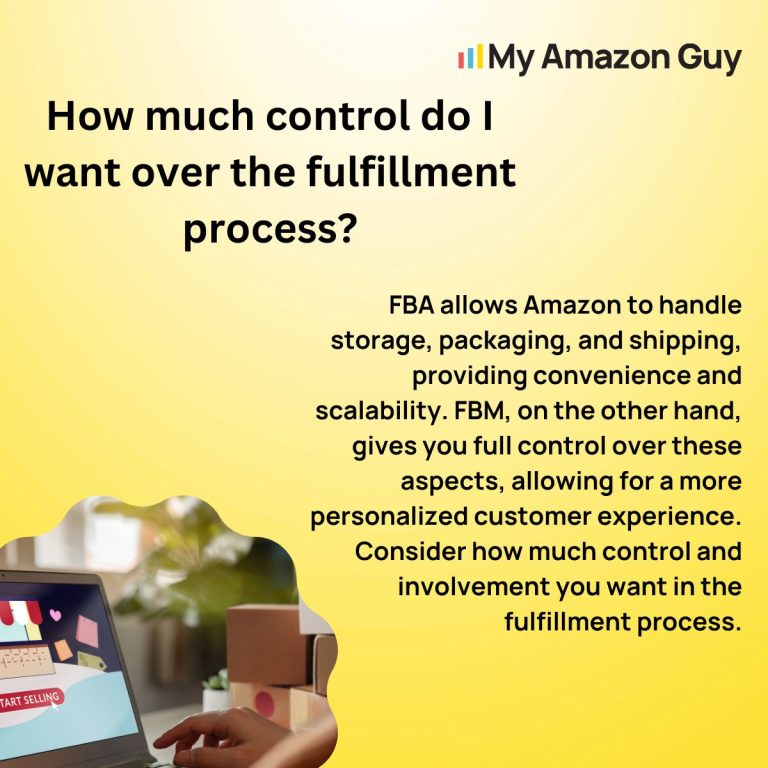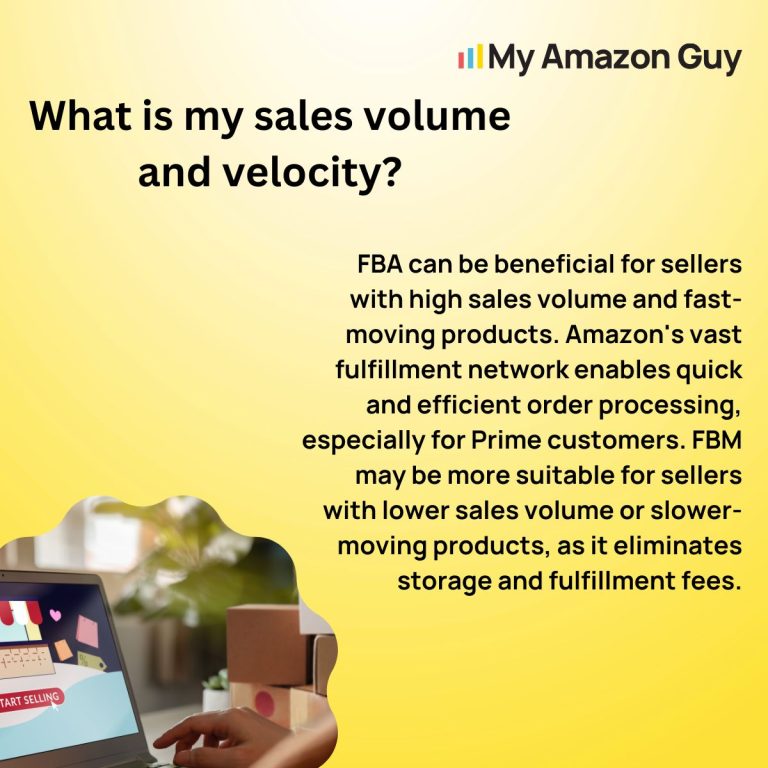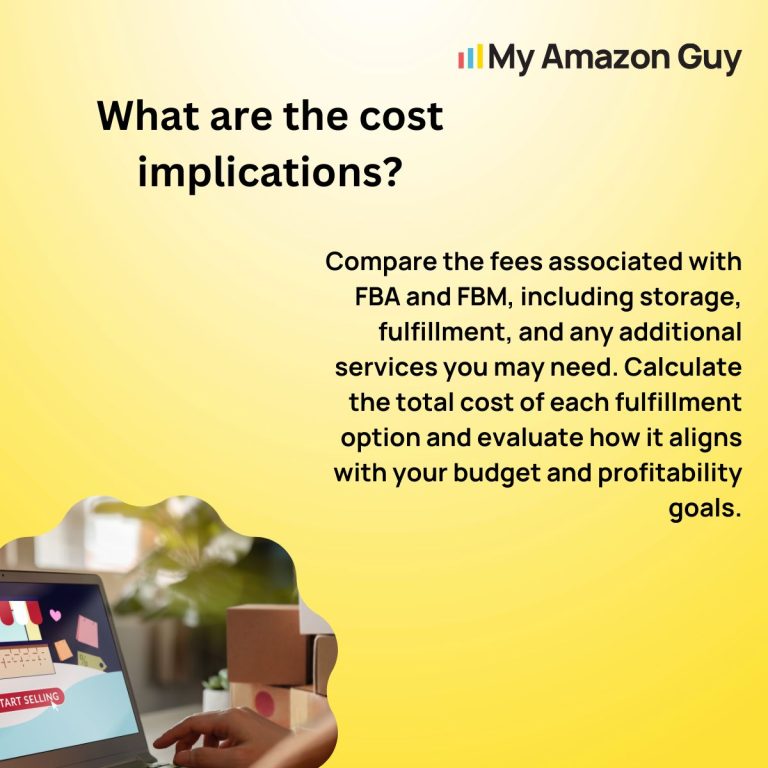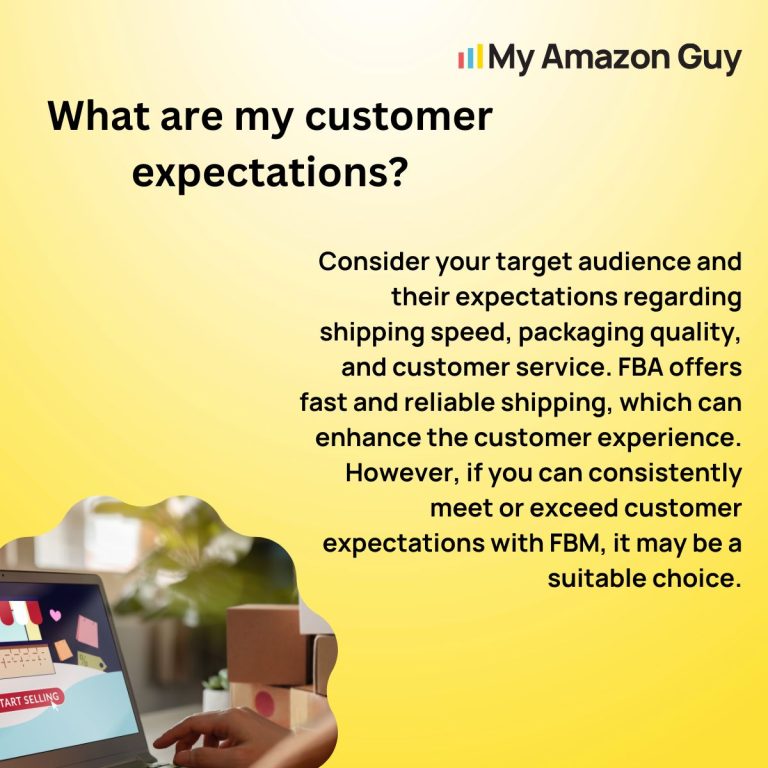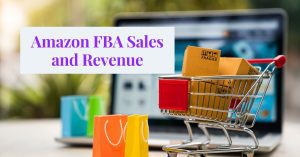Have you considered selling on Amazon without FBA? Although it is feasible, a comprehensive and detailed explanation is required to fully understand the process.
This blog post will provide valuable insights to aid in your decision-making process regarding selling on Amazon without FBA. Additionally, we will explore pertinent information related to selling on the platform through FBA.
Considerations For Selling on Amazon without FBA
The chart below shows that the majority of Amazon sellers use FBA. However, there are certain types of sellers who would benefit from selling on Amazon without FBA.
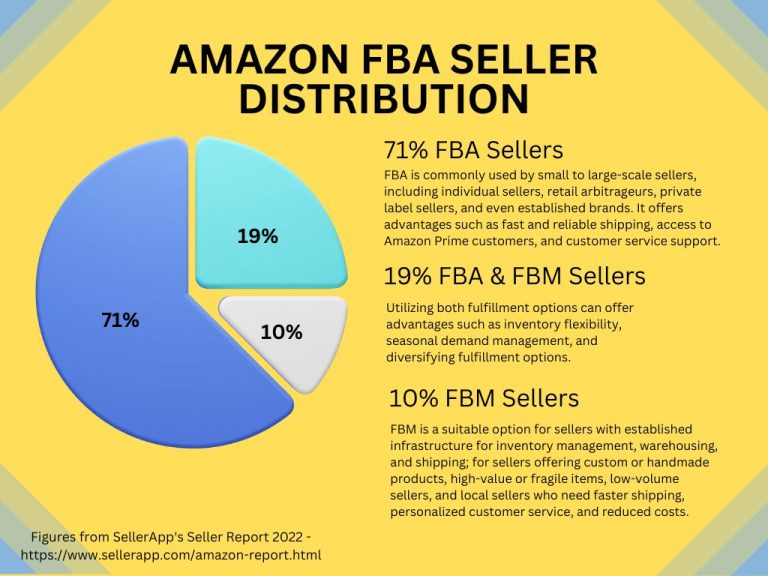
Understanding the fulfillment options on Amazon
Before deciding whether to sell on Amazon with or without FBA, it’s crucial to have a clear understanding of the fulfillment options available on the platform. Amazon offers two primary fulfillment methods: FBA and self-fulfillment or FBA (Fulfilled by Merchant).
Fulfillment by Amazon (FBA) is a service offered by Amazon where sellers send their inventory to Amazon’s fulfillment centers. Amazon then takes care of the storage, packaging, and shipping of the products. This allows sellers to focus on other aspects of their business while leveraging Amazon’s vast logistics network.
On the other hand, FBM means that sellers handle all aspects of order fulfillment themselves. This includes storing inventory, packaging orders, and shipping them directly to customers. While self-fulfillment requires more involvement from the seller, it also provides more control over the process.
Now that we’ve covered the basics of fulfillment options, let’s explore the pros and cons of self-fulfillment on Amazon.

FBM offers several benefits that may make it a viable option for your business.
- Maintain complete control over the fulfillment process. By managing your own inventory and shipping, you have the power to ensure that orders are fulfilled promptly and accurately.
- Opportunity for direct customer interaction. When you handle the fulfillment process, you have the chance to personalize the packaging and include personalized notes, enhancing the customer experience. This direct contact also allows you to address any customer inquiries or concerns promptly, fostering customer satisfaction and loyalty.
- Possible cost-effective option, especially for smaller sellers or those just starting. By avoiding FBA fees, you can potentially save on fulfillment costs, especially if your sales volume is relatively low. However, it’s important to carefully calculate your costs and profitability before committing to self-fulfillment.
FBM offers flexibility and control over the fulfillment process, but there are also a few drawbacks to consider:
- Increased workload, time-consuming. Sellers handle everything from storage, packaging, shipping, inventory management, carrier coordination, to customer service inquiries.
- Limited access to Prime benefits: FBM sellers lack Prime badge access, hindering visibility and conversion rates, as Prime members prioritize fast, free shipping, affecting their chances of winning Buy Box and attracting Prime customers.
- Higher shipping costs: FBM sellers face higher costs and challenges in offering competitive shipping options, potentially impacting customer satisfaction and conversion rates.
Which Types Of Sellers Suit The FBM Option?
FBM can be a suitable option for various types of sellers on Amazon, depending on their specific business needs and circumstances. Here are a few types of sellers that might find FBM beneficial:
- Small sellers or startups: FBM can be a good choice for small sellers or startups who are just starting out and have limited inventory or resources. It allows them to have more control over the fulfillment process and avoid the upfront costs associated with using FBA.
- Custom or handmade product sellers: Sellers who offer custom or handmade products often prefer FBM because they can provide a more personalized and unique fulfillment experience. They can have direct contact with customers, add custom packaging or branding, and maintain the quality control of their products.
- Large or heavy item sellers: FBM is often preferred by sellers who offer large or heavy items that may incur high storage fees or shipping charges through FBA. By fulfilling orders themselves, they can have more control over packaging, shipping methods, and potentially save on fulfillment costs.
- Restricted or prohibited product sellers: Some products are restricted or prohibited from being stored or shipped through FBA. In such cases, FBM is the only option for sellers to fulfill orders on Amazon.
Ultimately, the suitability of FBM depends on factors such as the seller’s inventory size, product type, fulfillment capabilities, cost considerations, and overall business goals. It’s important for sellers to analyze their specific needs and evaluate the advantages and disadvantages of FBM before making a decision.
If you have decided that selling on Amazon without FBA is the best route you can take, then keep reading to know more about how you can start.
How to start selling on Amazon without FBA?
Setting up your seller account and product listings for FBM
- Create an Amazon seller account: Visit the Amazon Seller Central website and click on the “Register now” button to create your seller account. You will need to provide information such as your business name, address, contact information, and bank account details.
- Choose the FBM option: During the registration process, make sure to select the FBM option to indicate that you will fulfill orders yourself.
- Verify your identity: Amazon may require you to verify your identity by providing additional information or documents. Follow the instructions provided to complete this step.
- Set up your seller profile: Once your account is created, you can set up your seller profile. This includes providing information about your business, such as your return policy, shipping options, and customer service contact details. Make sure to fill out all the required fields accurately.
- Add product listings: In your Amazon Seller Central dashboard, navigate to the “Inventory” tab and click on “Add a Product.” You can either search for existing product listings or create new ones. Fill in the details for each product, including the product title, description, images, pricing, and other relevant information.
- Specify FBM as the fulfillment method: When creating or editing your product listings, make sure to select FBM as the fulfillment method. This indicates that you will handle the storage, packaging, and shipping of the products.
- Set up shipping settings: Configure your shipping settings by specifying the shipping methods, rates, and regions you will serve. You can use Amazon’s shipping templates to simplify this process and ensure consistency across your listings.
Managing order fulfillment and shipping as an FBM seller
Below are two of the previously published videos of My Amazon Guy that can assist in managing FBM orders.
Calculating costs and profitability of self-fulfillment on Amazon
Before deciding to sell on Amazon without FBA, it’s crucial to understand the costs involved and assess the potential profitability. Here are some key factors to consider:
- Product costs of procuring or manufacturing your products, including any packaging materials.
- Shipping costs based on the size and weight of your products, as well as the shipping destinations.
- Storage costs associated with warehousing or renting storage space.
- Fulfillment costs of picking, packing, and shipping orders, including any labor or packaging materials required.
- Amazon fees: Although you won’t have FBA fees, Amazon charges various fees for selling on their platform. These include:
- Referral Fee is a percentage of the item’s sale price (excluding taxes and shipping) and varies based on the product category. It is typically around 6-20% of the item price.
- Variable Closing Fees in addition to the closing fee for some categories, such as media products. This fee is applied per item sold and varies based on the category.
- Sales volume: Analyze your sales projections to estimate your potential revenue and determine if the profitability outweighs the costs.

By meticulously calculating these costs and assessing the potential profitability, you can make an informed decision about whether selling on Amazon without FBA is viable for your business.
Tips for successful self-fulfillment on Amazon
Successfully self-fulfilling on Amazon requires careful planning and execution. Here are some tips to help you navigate the process:
- Accurate product listings: Ensure your product descriptions, images, and other details are accurate and informative to help customers make informed purchasing decisions.
- Competitive pricing: Research and analyze your competitors’ prices to set competitive pricing for your FBM products.
- Fast and reliable shipping: Ship orders promptly and provide tracking information to customers. Consistently meeting or exceeding delivery expectations can boost customer satisfaction.
- Excellent customer service: Be responsive to customer inquiries and resolve any issues promptly. Positive reviews and satisfied customers can lead to increased sales.
- Efficient inventory management: Keep track of your inventory levels to avoid overselling or running out of stock. Utilize inventory management tools or software to streamline the process.
- Optimize product visibility: Optimize your product listings with relevant keywords, clear titles, and bullet points to improve search rankings and visibility on Amazon. We’ll delve deeper into this topic below so keep reading.
- Professional packaging: Use quality packaging materials and ensure that products are properly protected during shipment. This helps prevent damage and enhances the overall customer experience.
- Monitor and respond to feedback: Regularly monitor customer feedback and reviews. Respond promptly to negative feedback and address any issues raised to maintain a positive brand reputation.
- Utilize advertising opportunities: Explore Amazon’s advertising options, such as Sponsored Products or Sponsored Brands, to increase product visibility and drive more traffic to your listings.
- Continual optimization: Regularly analyze your FBM performance metrics, such as sales, conversion rates, and customer feedback. Identify areas for improvement and make necessary adjustments to optimize your FBM strategy.
- Leverage technology: Utilize software and tools that integrate with Amazon’s platform to automate certain aspects of the fulfillment process. This can help streamline operations and improve efficiency.
Optimizing listings when selling on Amazon without FBA
Remember, a well-optimized listing with relevant keywords, clear and concise information, and high-quality images can help your products stand out and attract more potential buyers, regardless of whether you are using FBM or FBA.
Managing inventory and shipping for self-fulfillment on Amazon
Efficient inventory and shipping management is crucial for successful self-fulfillment on Amazon. Key strategies include
- regular inventory audits
- stock rotation using FIFO
- streamlined order processing
- choosing reliable carriers with competitive rates
- researching international shipping options for timely and cost-effective delivery
- software integration with Amazon
Customer service and reviews for FBM sellers
To ensure exceptional customer service and encourage positive reviews, Amazon sellers should prioritize prompt communication, order updates, clear policies for returns and refunds, proactive resolution, and follow-up with customers.
This will help build trust, minimize friction, and encourage positive reviews. By prioritizing these aspects, sellers can improve their reputation as self-fulfilled Amazon sellers, leading to increased sales and customer loyalty.
Alternative fulfillment options for selling on Amazon without FBA
While self-fulfillment is one option for selling on Amazon without FBA, it’s worth exploring alternative fulfillment options that can offer additional flexibility and scalability. Here are a few options to consider:
- Third-party logistics (3PL) providers: Partnering with a 3PL provider can offload the warehousing, fulfillment, and shipping responsibilities. This allows you to focus on other aspects of your business while leveraging their expertise and resources.
- Dropshipping: With dropshipping, you don’t need to hold inventory or handle shipping. Instead, the supplier fulfills the orders directly to the customer. This model can be beneficial for sellers who want to minimize upfront costs and inventory management.
- Multi-Channel Fulfillment (MCF): Amazon’s Multi-Channel Fulfillment service allows you to fulfill orders from other sales channels, such as your own website or other e-commerce platforms, using Amazon’s fulfillment network. This can be a convenient option if you already have inventory stored in Amazon’s fulfillment centers and want to leverage their shipping capabilities for non-Amazon orders.
- Hybrid approach: Combining self-fulfillment with FBA can be a viable option for some sellers. You can leverage FBA for certain products or during peak seasons while handling fulfillment for other products yourself.
Carefully assess your business needs, resources, and growth plans to determine which alternative fulfillment option aligns best with your goals.
Conclusion: Is selling on Amazon without FBA viable for your business?
In conclusion, selling on Amazon without FBA is feasible and can be a viable option for many businesses. It offers more control over the fulfillment process and direct customer interaction. However, it also requires careful management of inventory, shipping, and customer service.
Before deciding whether to sell on Amazon without FBA, weigh the pros and cons, assess the costs and profitability, and consider alternative fulfillment options. Each business is unique, and what works for one may not work for another.
By conducting thorough research, planning strategically, and implementing best practices, you can successfully navigate self-fulfillment on Amazon and achieve your business goals. Take the time to evaluate your options and make an informed decision that aligns with your long-term vision and objectives.
Bonus: Questions to ask yourself when choosing a fulfillment option

